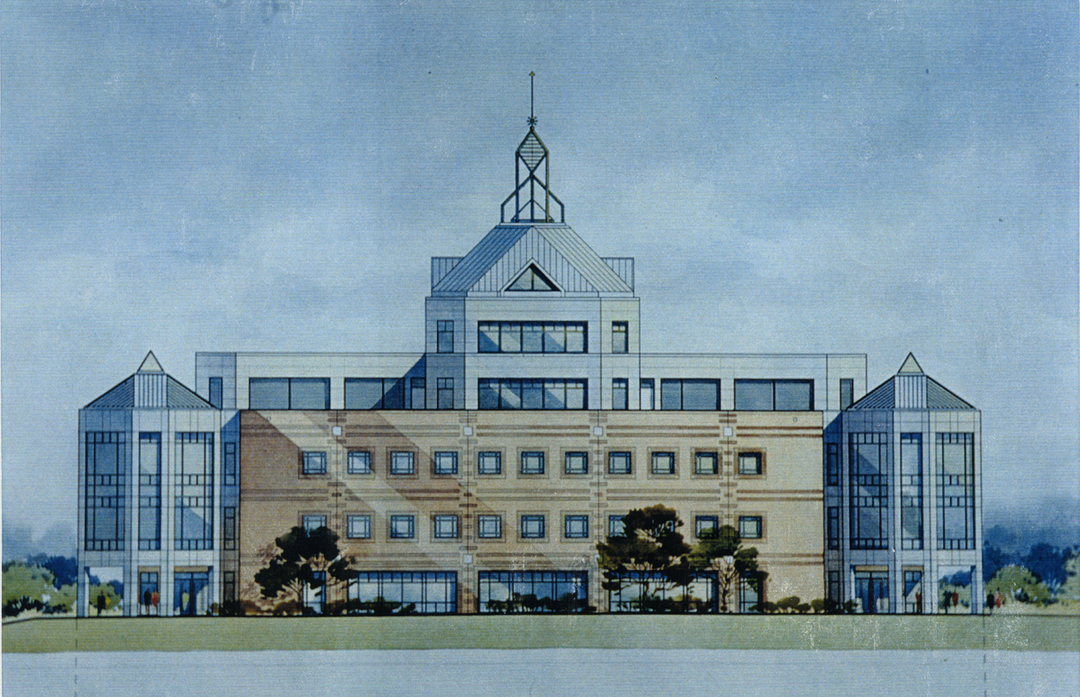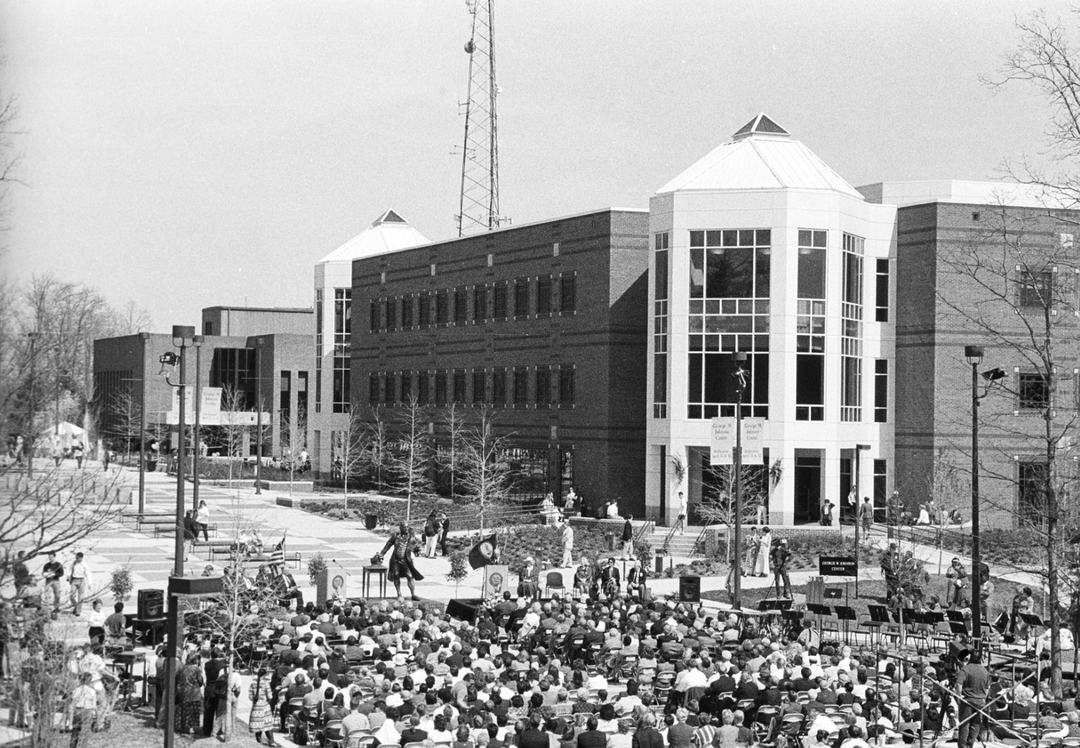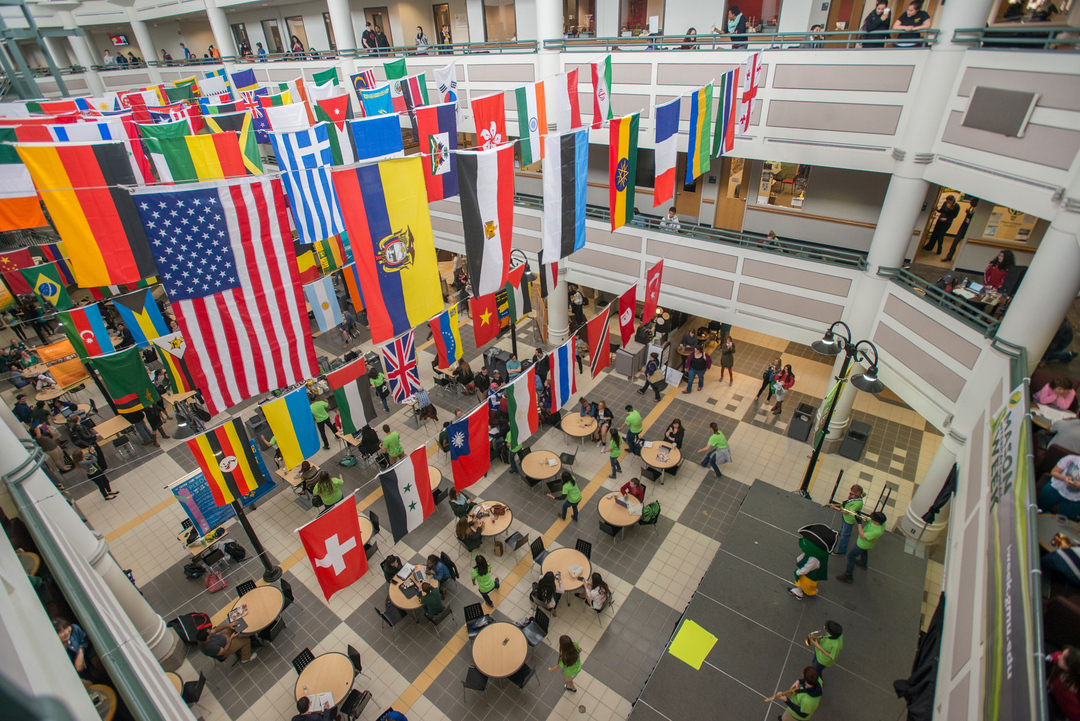The George W. Johnson Learning Center
The academic and community gathering place in the geographical center of Fairfax Campus.

Just to the south of Wilkins Plaza, is the George W. Johnson Learning Center. It is better known to George Mason University students and faculty as the Johnson Center, or simply the “JC” and is the most recognizable building on George Mason’s Fairfax Campus.
Completed in 1995, the George W. Johnson Learning Center is the centerpiece of the Fairfax Campus. It provides space for academic and other university gatherings, support for academic and administrative activities, food service, administrative spaces, and, simply, a place for students, faculty, and staff to meet and hang out.
The concept was originally suggested by the center's namesake, George W. Johnson, Mason's fourth president. Johnson arrived at Mason from Temple University in 1978. Under Johnson’s eighteen-year tenure as President the University acquired the School of Law and the new Arlington Campus, became a doctoral institution, began construction of its third campus, SciTech in Manassas, and greatly expanded its academic program offerings.
Key campus facilities, such as Student Union Building II, Patriot Center, Center for the Arts, and the Johnson Learning Center, were all constructed over the course of Johnson’s eighteen years as University President. Enrollment more than doubled from 10,767 during the fall of 1978 to 24,368 in the spring of 1996. The desire to create new academic programs and innovative centers and institutes for research while establishing Mason as an intellectual and cultural destination for the Northern Virginia community were hallmarks of Johnson’s tenure.
During the George W. Johnson era the University developed from an institution that was mostly local in scope to a major nationally recognized university. Johnson, in contrast to previous presidents, drove George Mason to expand and grow in new and innovative ways and emerge from relative obscurity.
Planning for a university “Learning Center” began in the early 1990s with library, faculty, and university administrators contributing input. This center should include a state-of-the-art library, a media center, bookstore, computer labs, study spaces, rooms for classes and meetings, an auditorium, restaurants, and a food court. The university stressed that this building would not be “Student Union Building III,” nor would it replace the two existing student unions. Up until the facility was opened, a popular rumor spread around campus that a bowling alley was part of the plans. University administrators were quick to dispel this notion.
Before construction could begin university administrators needed to remove a large structure dubbed the Humanities Module, which had previously occupied the space where the new building was to be built. The Humanities Module was a series of conjoined temporary buildings housing classrooms and lecture halls. The module was host to classroom subjects such as literature, economics, and music appreciation, from small classes to large lectures. The buildings that made up the Humanities Module were arranged so that students sometimes had to walk through other classes and lectures to move throughout the module. The Humanities Module was finally demolished in early 1993 to make way for the Learning Center. Modular classrooms continued to be in use at the University until the mid-2000s, and some modular offices are still in use at Mason today.
Sheppley-Bulfinch Architects of Boston Massachusetts designed the University Learning Center. Its design called for a ground floor that would have a large meeting area (today’s Dewberry Hall), a lower level of the planned bookstore, a staircase that would rise all the way to a third floor, and a “pub” area (today’s Bistro). The original first floor plans are almost identical to the current layout of the Johnson Center, although they did not specifically name a computer store on that level. The remaining drawings for the second and third floors accurately depict the layout of the current Johnson Center today.
The University Learning Center’s construction was completed in late spring of 1995. Administrators pushed to have the inside of the building ready for the new academic school year. The first part of the University Learning Center opened in October 1995 to much fanfare. The new building was twice the size of the Patriot Center, containing multiple computer labs and a 315-seat cinema. The cost then was $30 million for the facility which had over eight acres of floor space. Taco Bell, Sub Connection, and the Bistro were among the original restaurants serving food in the University Learning Center. A bakery, La Patisserie, originally based in Student Union Building I, moved to the Center just in time for its opening. Pizza Hut rounded out the food choices in 1995.
In August 1995, George W. Johnson, the University’s president since 1978, announced that he would retire at the end of the school year in 1996. Dr. Johnson at that point had been Mason’s longest serving and most successful president. During his tenure, the university expanded from a medium-sized local institution into a nationally recognized university with distributed campuses in Arlington and Manassas, a law school, and doctoral programs. To honor Dr. Johnson’s service and accomplishments, the University Learning Center would be dedicated to him and bear his name. On April 12, 1996, the University Learning Center was renamed the George W. Johnson Learning Center in a ceremony held on the North Plaza. Former Rector of the Board of Visitors and pivotal partner with Johnson in the expansion of the University, John T. “Til” Hazel gave the keynote speech. During the same ceremony, the eight-foot-tall statue of George Mason, sculpted by Wendy Ross was unveiled. Ross later created the George Mason Memorial in Washington D.C.
The Johnson Center has hosted several memorable and important university and community-related gatherings. In 1998, it was the home of the World Conference on Information Technology, attended by several notable IT leaders and featured appearances by former Russian president, Mikhail Gorbechev and former Prime Minister of England, Margaret Thatcher. The Center was filled during the 2006 NCAA Basketball Championship Tournament, when George Mason’s Patriots advanced to the Final Four by defeating the top-seeded University of Connecticut in overtime on March 24. Giant television screens placed on the atrium wall above the entrance to the bookstore at the north end permitted viewing by those in the packed atrium and on the floors above. In 2007, then Senator Barack Obama gave a pre-election campaign speech inside the Johnson Center. In later years, several other politicians visited the Johnson Center to rally supporters for their election campaigns. Every year during International Week, a long-time Mason tradition, flags of every nation are flown in the atrium, creating a colorful and festive atmosphere.
The George W. Johnson Learning Center stands an outward sign of Dr. George W. Johnson’s work to help make George Mason University what it is today.
Images







